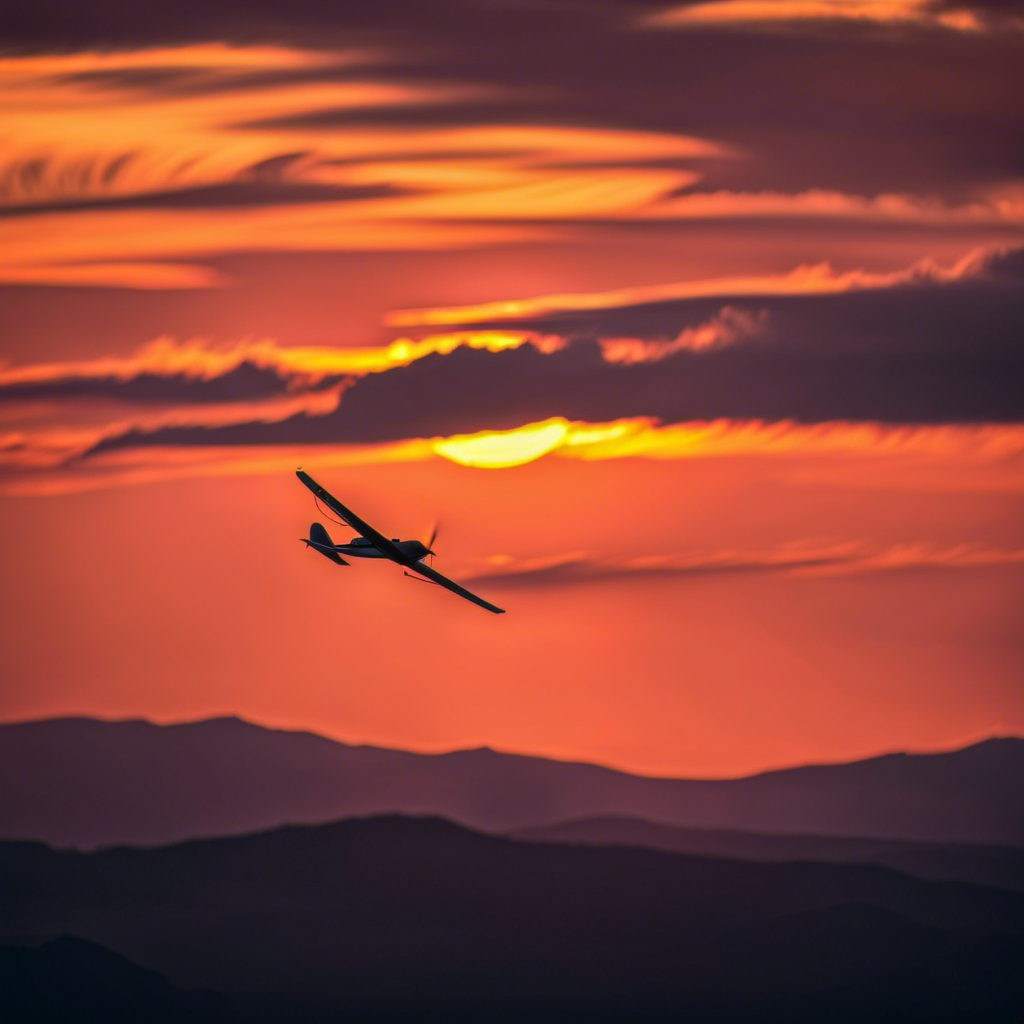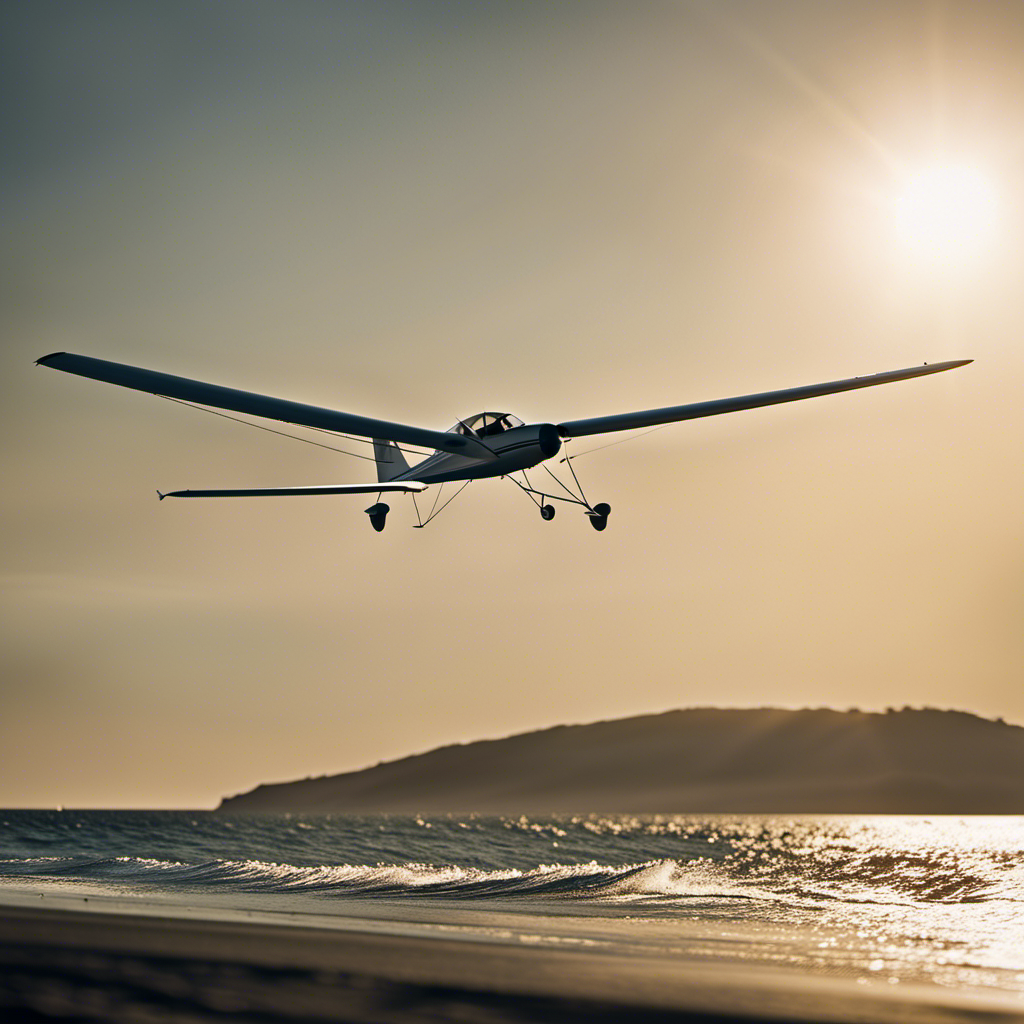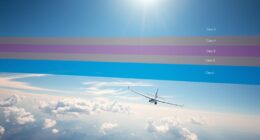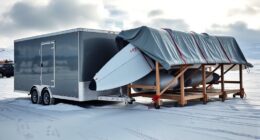As a glider pilot, I often think about how long these amazing aircraft can stay airborne. This question is both fascinating and thought-provoking to me.
In this article, we’ll delve into the factors that affect glider flight duration, from understanding thermal lifts to harnessing ridge and wave lifts. We’ll explore the performance and efficiency of gliders, along with strategies for prolonging flight.
Safety considerations and advancements in glider technology will also be discussed.
So, buckle up and join me on this thrilling journey through the skies.
Key Takeaways
- Factors such as the presence of thermals, glider aerodynamics, lightweight construction, and understanding thermal lifts affect the duration of glider flight.
- Lift techniques such as utilizing thermal lifts, ridge lift, and wave lift can extend the duration of glider flights.
- Glider performance and efficiency are influenced by factors such as weight distribution, wing design, aspect ratio, glide ratio, and sink rate.
- Safety considerations, including following safety precautions, regular maintenance and inspections, and adhering to regulations and guidelines, are crucial in glider flight.
Factors Affecting Glider Flight Duration
You might be wondering how factors like wind speed and thermals can affect how long a glider can stay in the air. Well, let me explain.
Thermal soaring, a technique used by glider pilots to extend their flight time, relies on the presence of rising columns of warm air called thermals. Glider aerodynamics plays a crucial role in maximizing the efficiency of exploiting thermals. Gliders are designed with a high aspect ratio wing, which means they have long, narrow wings. This design reduces drag and allows the glider to maintain altitude for longer periods.
Additionally, the glider’s ability to maneuver within thermals is enhanced by its lightweight construction and responsive controls. Understanding thermal lifts is essential for glider pilots as it enables them to identify and exploit these pockets of rising air, extending their flight duration without relying solely on wind speed.
Understanding Thermal Lifts
To maximize your time in the sky, it’s important to understand how thermal lifts work. Thermal lifts are columns of rising air created by the uneven heating of the Earth’s surface. Glider pilots use these updrafts to gain altitude and extend their flight duration. By employing specific soaring techniques, such as circling within the thermal lift, pilots can stay aloft for extended periods.
To better understand thermal lifts, consider the following table:
| Thermal Lifts | |
|---|---|
| 1 | Created by uneven heating of the Earth’s surface |
| 2 | Updrafts of rising air |
| 3 | Used by glider pilots to gain altitude |
| 4 | Soaring techniques, like circling, maximize time in the air |
Now, let’s transition to the next section about ridge lift and wave lift. These other types of lifts provide additional opportunities for gliders to stay aloft without relying solely on thermal lifts.
Ridge Lift and Wave Lift
When it comes to glider flights, understanding the mechanics of ridge lift is crucial.
Ridge lift occurs when wind hits an obstruction, like a mountain range, and is forced to rise, creating an upward current that gliders can utilize to stay aloft.
By strategically flying along the ridge, pilots can extend their flights and take advantage of this natural phenomenon.
Additionally, exploring wave lift, which is caused by the oscillations of the wind as it passes over mountains, can provide even greater benefits.
This allows gliders to soar to higher altitudes and cover longer distances.
How Ridge Lift Works
If you want to understand how ridge lift works, it’s important to know that it occurs when wind encounters a mountain or hill and is forced to rise. Here are the mechanics behind ridge lift and how it can optimize glider performance:
- Wind hits the windward side of the ridge or hill and is deflected upwards.
- As the air rises, it creates an area of low pressure on the leeward side of the ridge.
- Glider pilots can fly along the ridge, using the rising air to gain altitude and extend their flight time.
- To maximize the use of ridge lift, pilots must learn to read the wind patterns, find the optimal position along the ridge, and make precise adjustments to their glider’s flight path.
Understanding the mechanics of ridge lift is crucial for glider pilots looking to optimize their performance. By harnessing this natural phenomenon, they can utilize ridge lift for extended flights and stay aloft for longer periods without relying solely on thermals or other sources of lift.
Utilizing Ridge Lift for Extended Flights
By harnessing ridge lift, you can extend your flight time and optimize your performance as a glider pilot. Exploring ridge soaring techniques is essential for maximizing glider endurance.
Ridge lift occurs when wind encounters a mountain or hill, creating an upward force that gliders can utilize to gain altitude without the need for engine power. To take full advantage of ridge lift, it is important to understand the wind direction and speed, as well as the topography of the ridge.
By positioning the glider at the correct angle to the wind and flying along the ridge, you can maintain altitude and even climb. Additionally, using ridge lift efficiently allows you to cover long distances and stay airborne for extended periods of time.
Now, let’s explore wave lift and its benefits.
Exploring Wave Lift and its Benefits
Exploring wave lift allows pilots to gain altitude and optimize their performance without relying on engine power. Wave lift techniques are essential for maximizing glide performance in a glider. Here are three key aspects of wave lift that every pilot should understand:
-
Wave Formation: Wave lift is created by the interaction of wind and topographical features, such as mountains or hills. As the wind encounters these obstacles, it is forced to rise, creating a wave-like pattern in the air.
-
Riding the Wave: By positioning the glider in the rising air currents of the wave, pilots can gain altitude and extend their flight time. This technique allows for long-distance soaring and increases the glider’s range.
-
Energy Management: Understanding how to use wave lift effectively requires skillful energy management. By conserving and maximizing the potential energy gained from the wave, pilots can maintain altitude and stay aloft for extended periods.
Glider Performance and Efficiency
When it comes to glider performance and efficiency, there are several key factors to consider.
Firstly, the importance of weight and balance cannot be understated. Properly balancing the weight distribution in a glider is crucial for optimal handling and control.
Secondly, wing design and aspect ratio play a significant role in determining the glider’s performance. A higher aspect ratio wing generally results in improved efficiency and a higher glide ratio.
Lastly, the glide ratio and sink rate are important measurements of a glider’s performance. The glide ratio indicates how far the glider can travel horizontally for every unit of altitude lost, while the sink rate measures the rate at which the glider descends in still air.
Importance of Weight and Balance
Maintaining proper weight and balance is crucial for a glider to stay in the air for extended periods. The distribution of weight affects the performance and stability of the glider. Here are three key factors to consider:
-
Weight Distribution: Ensuring an even distribution of weight throughout the glider is essential. Imbalanced weight can lead to unstable flight, making it difficult to maintain altitude and control.
-
Trim Settings: Adjusting the trim settings allows for fine-tuning the glider’s balance. Properly setting the trim can optimize the glider’s performance, reducing drag and increasing efficiency.
-
Center of Gravity: The position of the glider’s center of gravity affects its stability and handling. A well-balanced center of gravity is necessary for smooth and controlled flight.
By understanding and managing weight distribution, trim settings, and center of gravity, pilots can maintain the optimal balance required for prolonged flight.
Transitioning to the next section, wing design and aspect ratio play a crucial role in achieving maximum gliding performance.
Wing Design and Aspect Ratio
Wing design and aspect ratio greatly impact a glider’s performance and efficiency. The shape and size of the wings determine the lift characteristics, which are crucial for sustaining flight.
A glider’s wings are typically long and slender, with a high aspect ratio. This means that the wings have a large span compared to their width. The high aspect ratio allows for reduced drag and increased lift, resulting in improved glide performance.
The wing design also includes features such as winglets, which help to minimize the formation of vortices and further enhance the efficiency of the wings.
Understanding the principles of wing design and aspect ratio is essential for maximizing a glider’s ability to stay in the air.
With this foundation, we can now delve into the next topic of glide ratio and sink rate.
Glide Ratio and Sink Rate
To improve your glider’s performance and efficiency, it’s important to understand the concept of glide ratio and sink rate. These two factors play a crucial role in determining how long a glider can stay in the air and how far it can travel.
Here are three key points to consider:
-
Glide Ratio: This refers to the distance a glider can travel horizontally compared to the vertical distance it descends. A higher glide ratio means the glider can cover more ground with each unit of altitude lost, increasing its flight endurance.
-
Sink Rate: This measures the rate at which a glider descends in still air. A lower sink rate allows the glider to stay aloft longer by minimizing altitude loss.
-
Thermal Soaring: Gliders can take advantage of thermal updrafts to gain altitude and extend their flight time. By circling within a thermal, gliders can maintain height and increase their overall flight endurance.
Understanding these concepts will lay the foundation for exploring strategies for prolonging glider flight without compromising performance or efficiency.
Strategies for Prolonging Glider Flight
One way pilots can extend glider flight time is by using thermals to gain altitude. Thermals are pockets of warm air that rise from the ground due to heating from the sun. By flying in circles within these thermals, glider pilots can climb higher and gain potential energy, which can then be converted into additional flight time.
To optimize glide performance, pilots also employ strategies such as finding areas of lift, avoiding areas of sink, and using ridge lift or wave lift when available. By carefully analyzing weather conditions, terrain features, and the performance characteristics of their glider, pilots can maximize their flight duration.
These strategies for prolonging glider flight are crucial when attempting to break world records and achieve the longest glider flights imaginable.
World Records and Longest Glider Flights
If you want to break world records and achieve the longest flights imaginable, you’ll need to focus on optimizing glide performance and utilizing strategies like finding lift and avoiding sink. The pursuit of long duration flights has led to incredible achievements in the world of glider aviation. Let’s take a look at some remarkable world records and the techniques that have been employed to maximize flight duration.
| World Record | Duration | Year |
|---|---|---|
| Longest Glider Flight | 1,026.5 miles | 2003 |
| Longest Time Aloft | 56 hours, 15 minutes | 1979 |
| Highest Altitude Reached | 49,009 feet | 2014 |
These records were not achieved by chance, but through meticulous planning and execution. Pilots meticulously analyze weather patterns, terrain, and glider performance to determine the ideal route and altitude. They also employ tactics like flying in thermals, where warm air rises, to gain altitude and extend their flight time. Additionally, pilots carefully avoid areas of descending air known as sink, which can significantly reduce flight duration.
Safety Considerations in Glider Flight
Now that we have explored the incredible world records and longest flights achieved in glider aviation, let’s delve into the safety considerations that are an integral part of every glider flight.
Glider pilots are well aware of the importance of safety precautions and the need for emergency procedures in case of unforeseen circumstances. Before takeoff, pilots carefully inspect the glider for any signs of damage or malfunction. They also ensure that all safety equipment, such as parachutes and emergency beacons, are properly secured.
During the flight, pilots constantly monitor weather conditions, paying close attention to any signs of turbulence or changing atmospheric conditions. In the event of an emergency, glider pilots are trained to execute emergency landing procedures, such as finding suitable landing spots and communicating distress signals.
By adhering to these safety measures, glider pilots can enjoy the exhilaration of flight while mitigating potential risks.
Transitioning to our next section, let’s explore the advancements in glider technology that have further enhanced the safety and performance of these remarkable aircraft.
Advancements in Glider Technology
To enhance your gliding experience, you’ll be amazed at the advancements in technology, from improved aerodynamics to state-of-the-art navigation systems. These advancements have revolutionized the performance of gliders, allowing for longer flights and better control. Let’s take a look at some of the key advancements in glider technology:
| Advancements | Performance Enhancement |
|---|---|
| Wing Design | Increased lift and reduced drag |
| Composite Materials | Lighter and stronger structures |
| Flap Systems | Improved maneuverability and glide ratio |
| Cockpit Instruments | Enhanced navigation and situational awareness |
| Safety Systems | Increased pilot protection and emergency capabilities |
These advancements have significantly improved the overall performance of gliders, making them more efficient and safer to fly. With better wing design and composite materials, gliders can generate more lift and endure longer flights. The addition of flap systems allows for better maneuverability and improved glide ratios. Advanced cockpit instruments provide pilots with accurate navigation and situational awareness, enhancing their ability to make informed decisions during flight. Furthermore, modern safety systems provide increased pilot protection and emergency capabilities. With these advancements, gliding has never been more exciting and rewarding.
Transitioning into the subsequent section about ‘gliding clubs and communities,’ the advancements in glider technology have not only improved individual gliding experiences but have also contributed to the growth of gliding clubs and communities worldwide.
Gliding Clubs and Communities
Joining a gliding club not only provides the opportunity to fly gliders, but it also offers a supportive community of fellow gliding enthusiasts.
Gliding clubs often organize regular competitions where pilots can showcase their skills and compete against each other. These competitions not only add excitement to the sport but also provide valuable networking opportunities and a chance to learn from more experienced pilots.
Joining a Gliding Club
If you’re interested in gliding, you might consider joining a gliding club. Not only will you have the opportunity to fly, but you’ll also gain access to networking opportunities and valuable learning experiences. Being part of a gliding club allows you to connect with like-minded individuals who share your passion for gliding. It’s a chance to exchange knowledge, tips, and tricks with experienced gliders. Additionally, gliding clubs often organize workshops, seminars, and training sessions to help members improve their skills and knowledge. To give you a glimpse of the benefits of joining a gliding club, here’s a table showcasing the networking opportunities and learning experiences you can expect:
| Networking Opportunities | Learning Experiences |
|---|---|
| Fly with experienced pilots | Attend workshops and seminars |
| Connect with fellow gliders | Participate in training sessions |
| Share knowledge and experiences | Learn from experienced gliders |
| Collaborate on gliding projects | Gain insights from guest speakers |
Participating in Gliding Competitions
Participating in gliding competitions offers a chance to showcase your skills and compete against other experienced pilots. Here are three strategies to consider for glider competitions:
-
Plan your flight path: Before the competition, study the terrain, weather conditions, and wind patterns to determine the most efficient route. This will help you maximize your glider’s performance and minimize the time spent in unfavorable conditions.
-
Master energy management: Gliders rely on exploiting rising air currents to gain altitude and extend flight time. Learn to identify thermals, ridge lift, and wave lift to stay aloft longer. Efficient energy management can give you a competitive edge.
-
Practice safety protocols: Glider flight safety is paramount in competitions. Ensure your glider is well-maintained, and perform pre-flight checks meticulously. Stay vigilant for other aircraft and follow all airspace regulations to avoid collisions.
By following these strategies, you can improve your performance in gliding competitions and increase your chances of success.
Networking and learning opportunities are also available within the gliding community, allowing you to further enhance your skills and knowledge.
Networking and Learning Opportunities
To expand your skills and knowledge in gliding, you can take advantage of networking opportunities and learning experiences within the gliding community. Connecting with other gliders through clubs, forums, and social media platforms can provide valuable connections and resources. Attending gliding events, workshops, and seminars can offer opportunities to learn from experienced gliders and industry experts. These networking opportunities can lead to mentorships, partnerships, and access to valuable insights and information.
Additionally, engaging in learning experiences such as training courses, flight simulations, and reading technical literature can deepen your understanding of gliding techniques and principles. By actively participating in the gliding community and seeking out these networking and learning opportunities, you can continuously grow and improve your skills as a glider pilot.
Transitioning into the subsequent section about ‘the joy of gliding,’ it is through these networking and learning experiences that I have come to truly appreciate the incredible thrill and freedom that gliding offers.
The Joy of Gliding
Gliding is a thrilling experience that allows me to soar through the sky. It is a form of unpowered flight that relies on the natural elements to stay airborne.
One of the most exciting aspects of gliding is thermic soaring. Thermals are columns of warm air that rise from the ground due to the heating of the Earth’s surface. Gliders can ride these thermals to gain altitude and stay aloft for extended periods of time. This technique is essential for cross country flying, where pilots aim to cover long distances.
Frequently Asked Questions
What are the safety considerations when flying a glider?
Safety precautions when flying a glider include thorough pre-flight checks, proper use of safety equipment, and adherence to air traffic control instructions. Pilot training is essential to ensure proficiency in handling emergencies and understanding glider-specific flight dynamics.
How has glider technology advanced over the years?
Glider advancements have led to improved materials, aerodynamics, and control systems. Future possibilities include longer flight durations through better energy storage and propulsion systems, as well as increased automation for safer and more efficient operation.
What are some strategies for prolonging glider flight?
To prolong glider flight, pilots utilize thermal currents, which are upward drafts of warm air. These currents can keep a glider airborne for hours, and skilled pilots can navigate them to cover long distances.
Are there any gliding clubs or communities that enthusiasts can join?
Yes, there are gliding clubs and communities that enthusiasts can join. These organizations provide a platform for glider pilots to connect, share experiences, and learn from each other. It’s a great way to be a part of the gliding community and expand your knowledge in this exciting sport.
What is the joy of gliding and why do people find it so appealing?
The joy of gliding comes from the thrill of soaring through the sky without an engine. People find it appealing because it offers a unique sense of freedom and a connection with nature.
Conclusion
In conclusion, the world of gliding is a captivating one. The skies become our playground, where we can defy gravity and embrace the freedom of flight. With the right conditions, skill, and technology, a glider can stay aloft for hours on end. Gliders have evolved to maximize performance and efficiency, harnessing thermal lifts, riding ridge and wave lifts.
If you’re seeking the thrill of soaring through the air like a bird, join a gliding club. Discover the joy of gliding for yourself and let your dreams take flight!









